Build your first integration
Make your first request to the Notion API.
Integration overview
In this guide, we’re going to build an internal Notion integration that can create a new database in your Notion workspace via a web form.
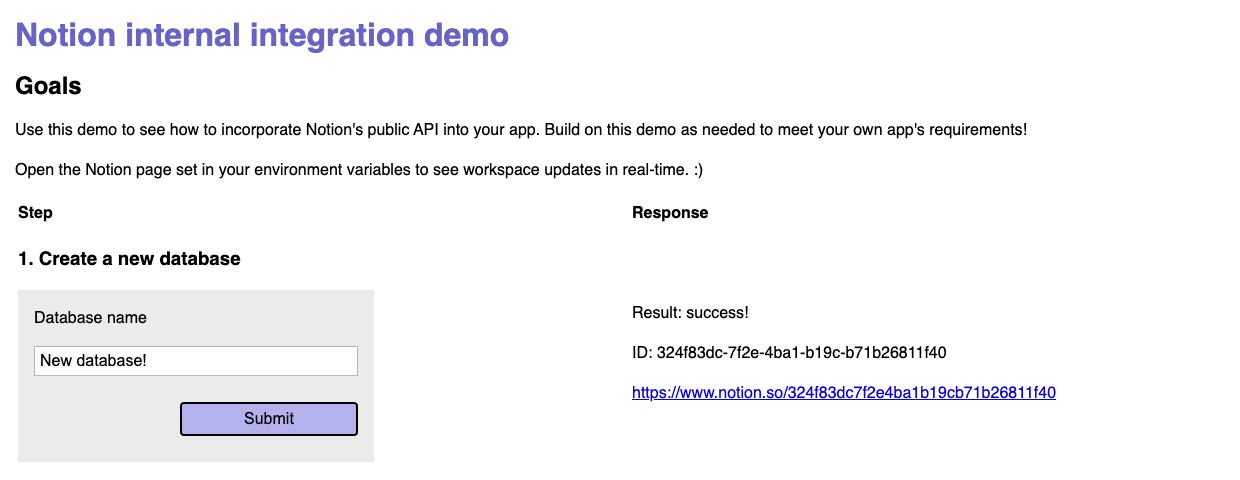
Demo web app that creates new databases in your Notion workspace.
Internal integrations are a good entry point to building integrations because they have a simpler authorization flow than public integrations.
Before diving in, let’s quickly review Notion integrations. Integrations define how the public API can programmatically interact with your Notion workspace. They need to be authorized (i.e., given explicit permission) to make any changes your workspace.
All integration types use Notion’s public API to make requests to update a Notion workspace. The specific use case for each integration can vary greatly, from using Notion as a CMS for a blog, to tracking Github issues, to sending emails in response to Notion changes.
This guide is just one introductory example of what you can build with Notion’s public API.
Today’s goals
This guide will demonstrate how to build an HTML form that will create a new Notion database when submitted.
By the end of this guide, we’ll have a functional app that looks like this:
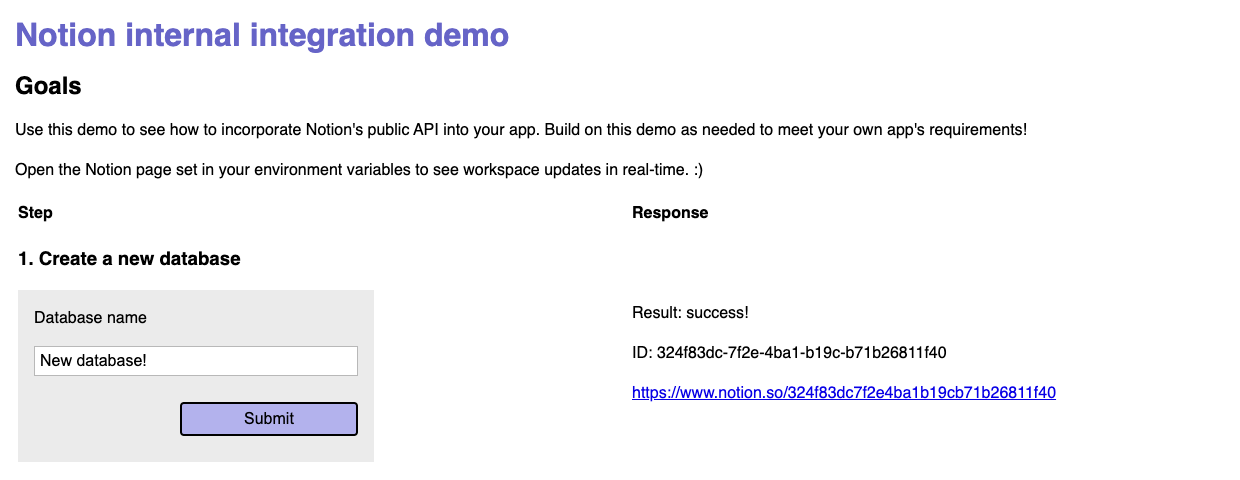
Database form UI.
The completed sample code includes additional examples beyond what’s covered in this guide, including forms to:
- Add a new page to the database
- Add content to the new page
- Add a comment to the page content
Requirements
To follow along with this guide, you will need:
- A Notion account.
- To be a Workspace Owner in the workspace you’re using. You can create a new workspace for testing purposes otherwise.
- Knowledge of HTML and JavaScript. We’ll use Express.js for a server, as well.
- npm and Node.js installed locally to use the Notion SDK for JavaScript and Express.js
The sample code shown below uses the Notion SDK for JavaScript to make public API requests. Using the Notion SDK for JavaScript is not required to build a Notion integration, but many JavaScript developers prefer it due to its ease of use.
Getting started
Create your integration in Notion
The first step to building any integration (internal or public) is to create a new integration in Notion’s integrations dashboard: https://www.notion.com/my-integrations.
- Click
+ New integration. - Enter the integration name.
- (Optional) If you're using the completed sample app with the comment form as well, update the
Capabilitiesto allow comment interactions.
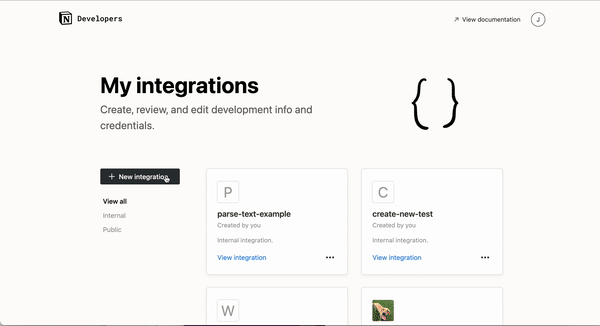
Navigating the integrations dashboard to create a new internal integration.
The integration will be internal by default. If you are building a public integration, you will need to make it public under the Distribution tab.
Get your API secret
API requests require an API secret to be successfully authenticated. Visit the Secrets tab to get your integration’s API secret (or “Internal Integration Secret”).
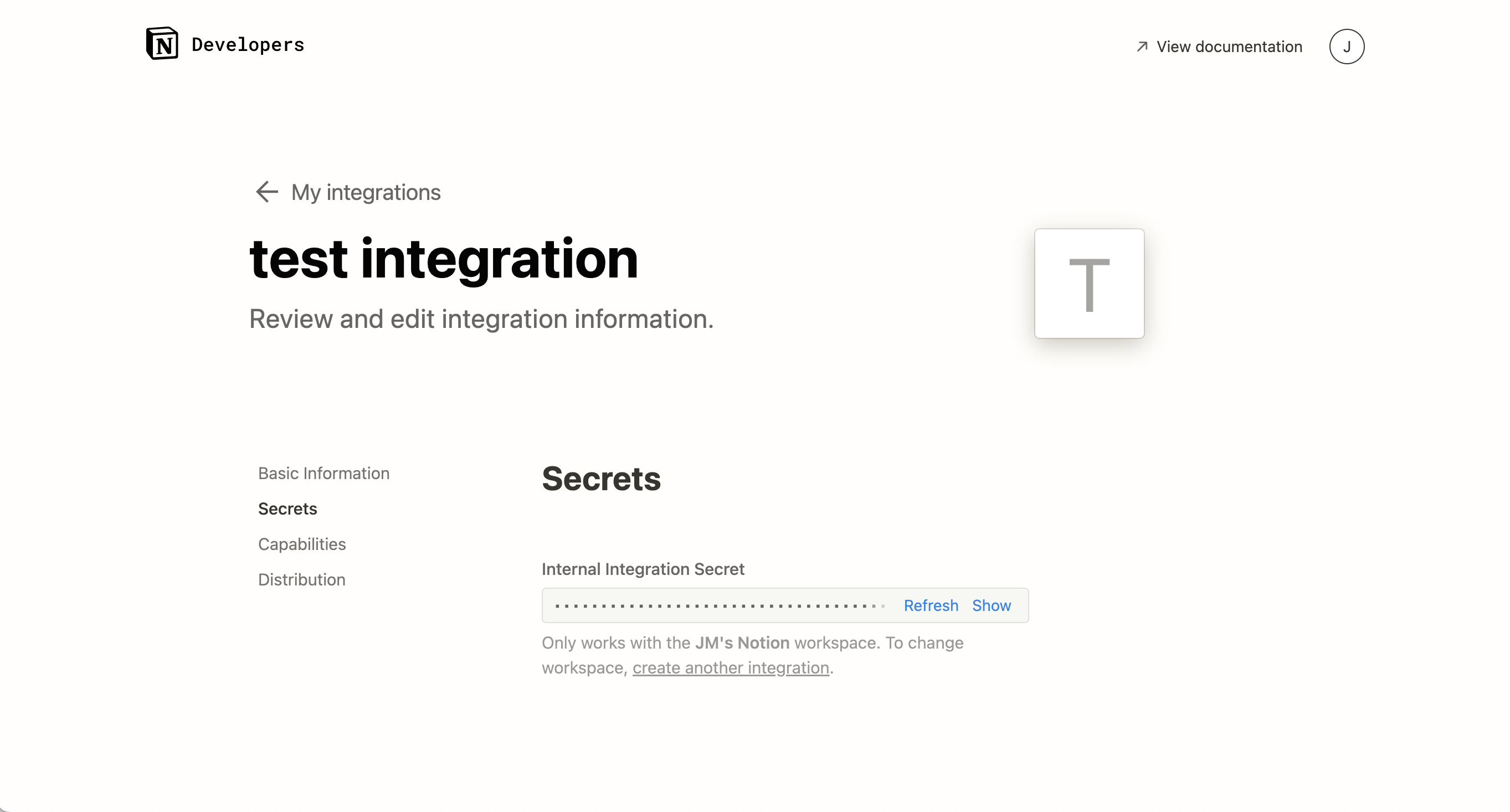
Secrets tab in integrations dashboard.
Keep your API secret a secret!
Any value used to authenticate API requests should always be kept secret. Use environment variables and avoid committing sensitive data to your version control history.
If you do accidentally expose it, remember to “refresh” your secret.
Give your integration page permissions
The database that we’re about to create will be added to a parent Notion page in your workspace. For your integration to interact with the page, it needs explicit permission to read/write to that specific Notion page.
To give the integration permission, you will need to:
- Pick (or create) a Notion page.
- Click on the
...More menu in the top-right corner of the page. - Scroll down to
+ Add Connections. - Search for your integration and select it.
- Confirm the integration can access the page and all of its child pages.

Give your integration permission to add a database to a page.
Your integration can now make API requests related to this Notion page and any of its children.
If you are building a public integration, use the authorization instructions included in the Authorization guide instead.
If your API requests are failing, confirm you have given the integration permission to the page you are trying to update. This is a common cause of API request errors.
Setting up the demo locally
In this example, we’ll have three key files:
index.html, which will contain our client-side markdown (HTML).client.js, which will contain our client-side JavaScript code.server.js, which will contain our server-side JavaScript code. This file contains all the endpoints to make requests to Notion’s public API, as well as to serve theindex.htmlfile. (More on that below.)
All of the sample code is available in GitHub.
This integration includes frontend code, but integrations can be server-side only, as well. See more examples of different integration use cases in GitHub.
Clone demo repo
To run this project locally, clone the repo and install its dependencies (Express.js, dotenv, and Notion’s SDK for JavaScript):
# Clone this repository locally
git clone https://github.com/makenotion/notion-sdk-js.git
# Switch into this project
cd notion-sdk-js/examples/web-form-with-express/
# Install the dependencies
npm install
Environment variables
In your .env file, add the following variables:
NOTION_KEY=<your-notion-api-key>
NOTION_PAGE_ID=<parent-page-id>
Add the API secret you retrieved in Getting Started to NOTION_KEY, as well as a page ID (NOTION_PAGE_ID) for the page that you gave the integration permission to update.
When using the API to create a database, the parent of a database must be a Notion page or a wiki database. To get the ID of the page, locate the 32-character string at the end of the page’s URL.
As a best practice, add .env to your .gitignore file to ensure you don’t accidentally share these values.
Running the project locally
To run this project locally, you will need to enter the following command in your terminal:
node server.js
Next, let’s look at how our database form works.
Creating a new database
Step 1: Adding a database form (index.html)
index.html)In our index.html file, we need a form for the user to create a new database and an area for the API response to be displayed. This is how the user will initiate a public API request.

App design for creating a database.
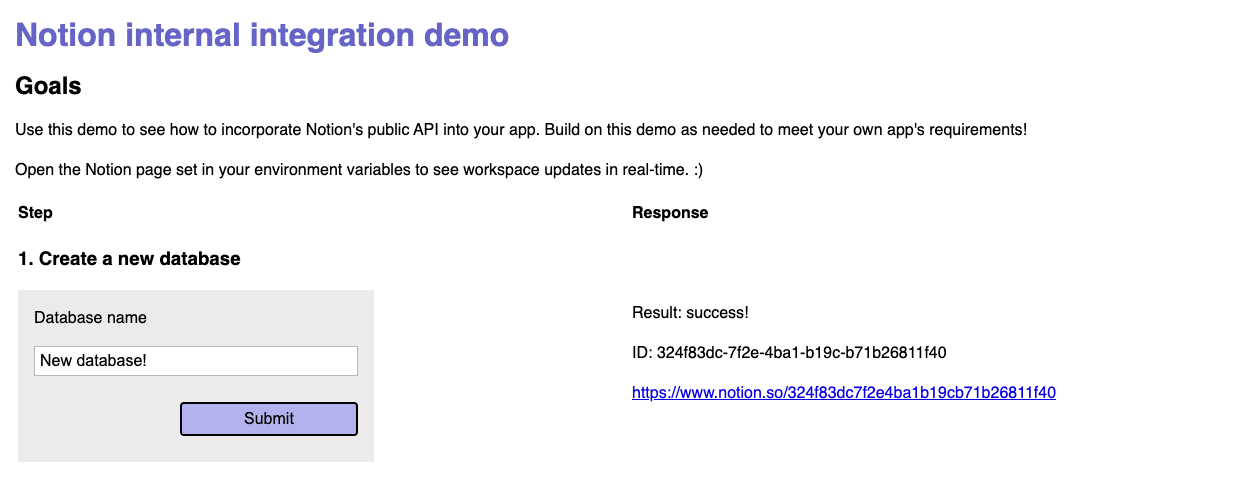
Rendered app design for creating a database.
The corresponding HTML elements related to creating a database are shown below:
<!DOCTYPE html>
<html lang="en">
<head>
...
<!-- Import the webpage's stylesheet -->
<link rel="stylesheet" href="/style.css" />
<!-- Import the webpage's client-side javascript file -->
<script src="/client.js" defer></script>
</head>
<body>
...
<table>
...
<tr>
<td>
<h3>1. Create a new database</h3>
<!-- Form to create a database -->
<form id="databaseForm">
<label for="dbName">Database name</label>
<input type="text" id="dbName" />
<input type="submit" />
</form>
</td>
<!-- Empty table cell to append the API response to -->
<td id="dbResponse"></td>
</tr>
...
</table>
</main>
...
</body>
</html>
In terms of what’s rendered in the <body>, notice the <form> element and an empty table cell with the ID dbResponse. The latter is where we’ll append the Notion API response information.
The database form includes two inputs:
- A text input for the database name
- A submit input to submit the form
Also of note: the client.js file is included in the document’s <head> tag, which allows us to apply client-side JavaScript to interact with these HTML elements.
Step 2: Handling the form submission (client.js)
client.js)In client.js, we can write a function to describe what should happen when the database form is submitted. In short, we want to make a request to server.js to then make an API request to Notion. The actual Notion API request will happen server-side to avoid exposing our API secret in the client. (In other words, it’s more secure!)
// Assign the database form to a variable for later use
const dbForm = document.getElementById("databaseForm");
// Assign the empty table cell to a variable for later use
const dbResponseEl = document.getElementById("dbResponse");
// Add a submit handler to the form
dbForm.onsubmit = async function (event) {
event.preventDefault()
// Get the database name from the form
const dbName = event.target.dbName.value
const body = JSON.stringify({ dbName })
// Make a request to /databases endpoint in server.js
const newDBResponse = await fetch("/databases", {
method: "POST",
headers: {
"Content-Type": "application/json",
},
body,
})
const newDBData = await newDBResponse.json()
// Pass the new database info and the empty table cell
// to a function that will append it.
appendApiResponse(newDBData, dbResponseEl)
}
In this code block, we select the form element using its ID attribute with getElementbyId().
Next, we attach an async function to the onsubmit event that will make a request to our local server’s /databases endpoint. (This endpoint will be described below in our server.js code.) The function is asynchronous because we need to wait for a response from our server before proceeding.
The response is then appended to our index.html document. (More on this below.)
Step 3: Importing the Notion SDK (server.js)
server.js)Let's start by looking at our server.js file without the Notion-related endpoints:
require("dotenv").config();
const express = require("express");
const app = express();
// Notion SDK for JavaScript
const { Client } = require("@notionhq/client");
const notion = new Client({ auth: process.env.NOTION_KEY });
// <http://expressjs.com/en/starter/static-files.html>
app.use(express.static("public"));
// <http://expressjs.com/en/starter/basic-routing.html>
app.get("/", function(request, response) {
response.sendFile(__dirname + "/views/index.html");
});
// listen for requests
const listener = app.listen(process.env.PORT, function() {
console.log("Your app is listening on port " + listener.address().port);
});
This Express.js code will listen for requests to / (e.g., localhost:<port>/) and respond with the index.html file. That’s how the app knows to render our index.html code when the server is started.
To use the SDK, we import it at the top of server.js. We also initialize a new Notion Client instance and set the auth option to the Notion API secret already set in the environment variables:
const { Client } = require("@notionhq/client");
const notion = new Client({ auth: process.env.NOTION_KEY });
We can now make requests to Notion’s API in this file without having to worry about authentication again.
Step 4: Handling the form’s POST request (server.js)
server.js)Staying in server.js, we can add the following code that will be invoked when the database form makes a POST request to /databases:
app.post("/databases", async function (request, response) {
const pageId = process.env.NOTION_PAGE_ID;
const title = request.body.dbName;
try {
// Notion API request!
const newDb = await notion.databases.create({
parent: {
type: "page_id",
page_id: pageId,
},
title: [
{
type: "text",
text: {
content: title,
},
},
],
properties: {
Name: {
title: {},
},
},
});
response.json({ message: "success!", data: newDb });
} catch (error) {
response.json({ message: "error", error });
}
});
app.post() indicates this endpoint is for POST requests, and the first argument ("/databases") indicates this function corresponds to requests made to the /databases path, as we did in our client-side code above.
Next, we can actually interact with the Notion API.
To create a new database, we’ll use the Create a database endpoint:
await notion.databases.create({...options})
To use this endpoint, we need to pass the parent page ID in the body parameters. This page ID is the one already set in the environment variables. The page ID must be included in this request.
const pageId = process.env.NOTION_PAGE_ID;
...
try {
const newDb = await notion.databases.create({
parent: {
type: "page_id",
page_id: pageId,
},
...
(Note: Environment variables can only be accessed in server.js , not client.js.)
In this example, the title of the database should also be set. The title was provided in the form the user submitted, which we can access from the request’s body (request.body.dbName).
const pageId = process.env.NOTION_PAGE_ID;
const title = request.body.dbName; // Get the user's title
try {
const newDb = await notion.databases.create({
parent: {...},
title: [
{
type: "text",
text: {
content: title, // Include the user's title in the request
},
},
],
Finally, we need to describe the database’s properties. The properties represent the columns in a database (or the “schema”, depending on which terminology you prefer.)
In this case, our database will have just one column called “Name”, which will represent the page names of its child pages:
try {
const newDb = await notion.databases.create({
parent: {...},
title: [...],
properties: {
Name: {
title: {},
},
},
})
...
Finally, assuming the request works, we can return the response from Notion’s API back to our original fetch request in client.js:
...
response.json({ message: "success!", data: newDb });
If it doesn’t work, we’ll return whatever error message we get from Notion’s API:
try {
...
} catch (error) {
response.json({ message: "error", error });
}
Now that we have our new database, the response can be added to the HTML document via the client-side JavaScript (client.js).
Step 5: Displaying the response (index.html)
index.html)Let’s first look at an example of the object the /databases endpoint responds with, which includes the object that gets returned from the Notion API when we create a new database:
{
message: "success!",
data: { // from Notion
object: "database",
id: "e604f78c-4145-4444-b7d5-1adea4fa5d08",
cover: null,
icon: null,
created_time: "2023-07-18T20:56:00.000Z",
created_by: { object: "user", id: "44b170f0-16ac-47cf-aaaa-8f2eab66hhhh" },
last_edited_by: {
object: "user",
id: "44b170f0-16ac-47cf-gggg-8f2eab6rrrra",
},
last_edited_time: "2023-07-18T20:56:00.000Z",
title: [
{
type: "text",
text: [Object],
annotations: [Object],
plain_text: "test db",
href: null,
},
],
description: [],
is_inline: false,
properties: {
Name: { id: "title", name: "Name", type: "title", title: {} },
},
parent: {
type: "page_id",
page_id: "e7261079-9d30-4313-9999-14b29880gggg",
},
url: "<https://www.notion.so/e604f78c414548c6b7d51adea4fadddd>",
public_url: null,
in_trash: false,
},
}
The most important information here (for our purposes) is the database ID (data.id). The ID will be required to make API requests to the Create a page endpoint, which is the next form in our completed demo’s UI.
Knowing this JSON structure, let’s now look at how appendApiResponse() works:
const dbForm = document.getElementById("databaseForm");
// Empty table cell where we'll display the API response
const dbResponse = document.getElementById("dbResponse");
...
// Appends the API response to the UI
const appendApiResponse = function (apiResponse, el) {
// Add success message to UI
const newParagraphSuccessMsg = document.createElement("p")
newParagraphSuccessMsg.innerHTML = "Result: " + apiResponse.message
el.appendChild(newParagraphSuccessMsg)
// See browser console for more information if there's an error
if (apiResponse.message === "error") return
// Add ID of Notion item (db, page, comment) to UI
const newParagraphId = document.createElement("p")
newParagraphId.innerHTML = "ID: " + apiResponse.data.id
el.appendChild(newParagraphId)
// Add URL of Notion item (db, page) to UI
if (apiResponse.data.url) {
const newAnchorTag = document.createElement("a")
newAnchorTag.setAttribute("href", apiResponse.data.url)
newAnchorTag.innerText = apiResponse.data.url
el.appendChild(newAnchorTag)
}
}
appendApiResponse(res, form) accepts two parameters: the response (shown above) and the HTML element where we will append the response — in this case, an empty table cell next to the database form.
In this function, we first add a paragraph element to show the response message (i.e., whether it was a success or the error).
const newParagraphSuccessMsg = document.createElement("p")
newParagraphSuccessMsg.innerHTML = "Result: " + apiResponse.message
el.appendChild(newParagraphSuccessMsg)
Then, we do the same with the database ID after confirming the response was not an error:
if (apiResponse.message === "error") return
// Add ID of database to UI
const newParagraphId = document.createElement("p")
newParagraphId.innerHTML = "ID: " + apiResponse.data.id
el.appendChild(newParagraphId)
Finally, if the response has a URL, we display that too with an anchor (<a>) tag. This allows the user to visit the database directly in Notion.
if (apiResponse.data.url) {
const newAnchorTag = document.createElement("a")
newAnchorTag.setAttribute("href", apiResponse.data.url)
newAnchorTag.innerText = apiResponse.data.url
el.appendChild(newAnchorTag)
}
(Note: This function will be reused by other forms. Not all responses have a url property, which is why we check for it.)
Once this is done, our HTML document is updated and the form submission is officially complete.
Testing the feature
Let’s see the final results of testing this new feature:
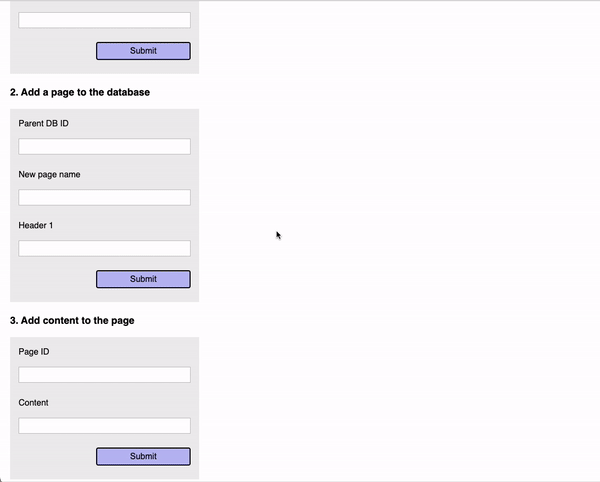
Submitting the database form and visiting the Notion URL from the response.
The database form is submitted and the response from Notion's API is appended to our UI. 🎉 We can click the link to visit the new database in Notion and confirm it worked as expected.
As a next step, the new database ID can be copy and pasted into the page form below it to create a new page in the database. We can also use the page ID that the page form returns to add content to the page or comment on it using the block and comment forms.
We won’t cover the code for page, blocks, or comment forms here, but the code is all included in the source code for reference. It works the same as the database example.
As a next step, you could also try adding a feature to retrieve all existing pages in the database, or retrieve block children (i.e., page content) for an existing page.
Wrapping up
This guide demonstrated how to use Notion’s public API (via the Notion SDK for JavaScript) to build an internal integration. With this demo app, users can programmatically create a new database in their Notion workspace by filling out a form in the app UI and making a request to Notion’s public API — the Create a database endpoint.
As a reminder, this example includes client-side code to allow for user interactions via a GUI (graphical user interface). Notion integrations do not require a UI, however. What you build is completely up to you!
To see examples of server-side-only integrations, test out the sample apps in the SDK’s GitHub repo.
Next steps
To learn more about authorizing API requests or to learn how to add an auth flow to your public integration, read the Authorization guide next.
Additional resources
Updated 16 days ago
